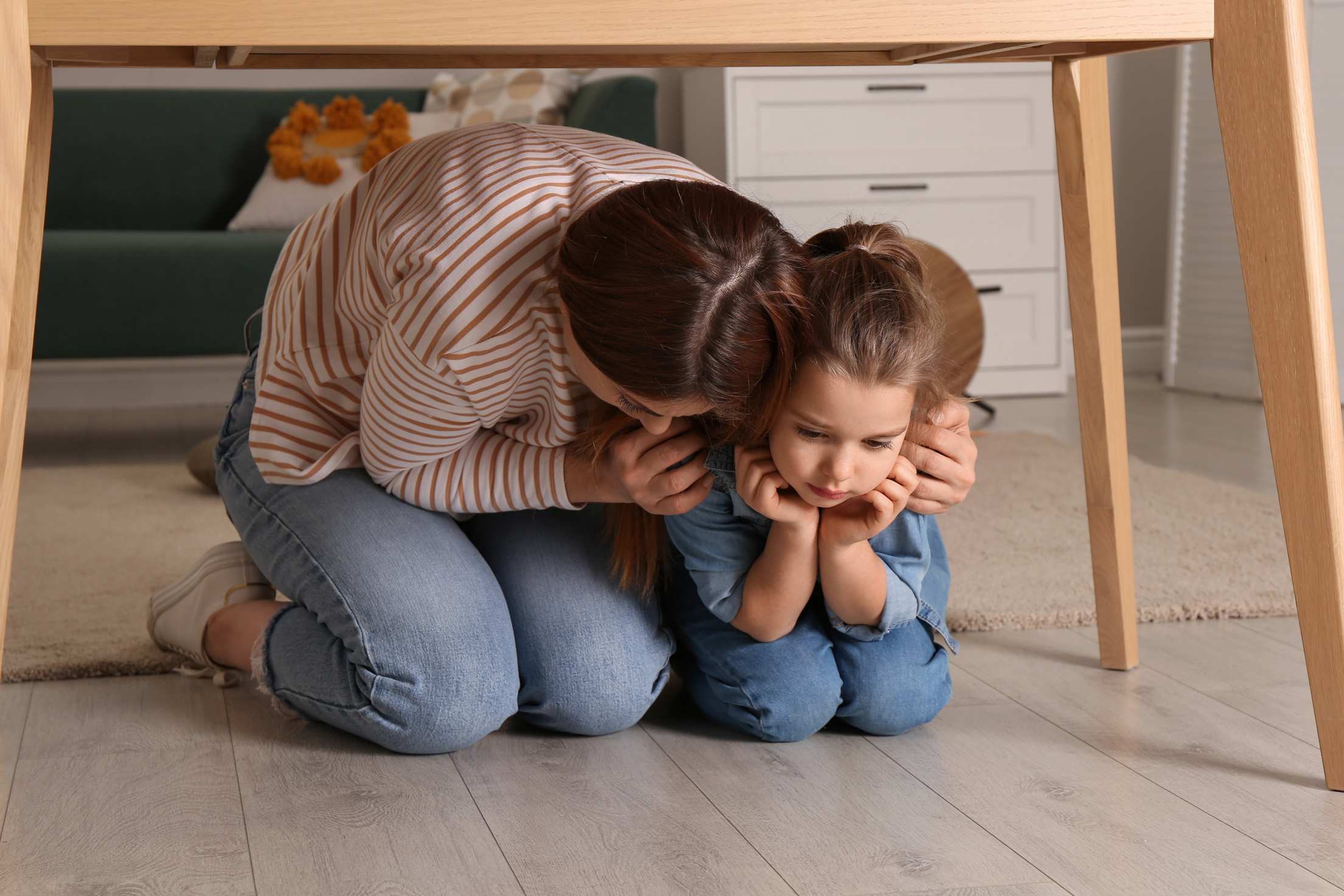
What Should You Do When an Earthquake Starts?
Plus, where is the safest place to be when it hits?

You think your home is prepared for an earthquake: You’ve retrofitted your foundation, secured your hot water heater and tall furniture, and stocked up on food and water. But when the shaking starts, will you know—or remember—what to do?
1. React as soon as you get an alert.
The USGS ShakeAlert system provides warnings for California, Oregon, and Washington, which are delivered to various apps such as MyShake, a project of the Berkeley Seismology Lab. It provides free alerts to Apple and Android phones and tablets. It’s also available on Chromebooks and MacBook computers [meeting minimum operating system requirements], says Angela Lux, seismologist with the Berkeley Seismology Lab.
Google is now delivering early quake warnings to all Android phones with updated operating systems nationwide, without the need to install an app.
ShakeAlert gives users “a few seconds or tens of seconds” of advance notice before a quake reaches them. The farther you are from the epicenter, the more warning you get before the shaking starts at your location. “If you are right at the epicenter, you are likely to receive a warning when shaking begins, or shortly thereafter,” Lux said. This can confirm that this is indeed an earthquake, so take immediate action.
2. Stay out of the doorway.
The best place to be when an earthquake strikes depends on where you are, but some conventional wisdom is outdated or simply not true in most situations. For example, unless you are in an adobe building, don’t stand in a doorway.
“People remember seeing pictures of old adobe buildings in California where the only thing left standing is the door frame,” says Lux. “We don't live in adobe buildings anymore. There is nothing about a door frame that is more structurally sound than any other part of the building.”
Building codes in the Western United States have been designed to reduce the risk of injury from an earthquake. Studies of quakes in California, New Zealand, and countries with similar seismic safety codes have shown that the chance of being hit by falling or flying objects—inside or outside a building—is much higher than being trapped in the rubble of a collapsed building.
In the 1994 Northridge, California, earthquake, at least 57 people died from collapsed buildings and other causes (excluding heart attacks). But at least 9,000 were injured by falling debris, broken glass, and other hazards.
That’s why earthquake experts say the best way to stay safe is to “drop, cover, and hold on.”
3. Drop to your hands and knees.
Forget trying to run out the door. In a strong earthquake, you could easily be knocked off your feet. If you manage to make it outside, you could be hit by tumbling windows, facades, or architectural details, according to the Earthquake Country Alliance, a consortium of California earthquake experts.
Sara McBride, a research social scientist with the U.S. Geological Survey, studies videos of people trying to move during earthquakes. “I have video analysis from Taiwan where people were outside in a forest and they had trouble standing up in the intense shaking of a large-magnitude earthquake,” she says.
Instead of running, drop to your knees. “This position protects you from being knocked down and also allows you to stay low and crawl to shelter if nearby,” the Federal Emergency Management Agency says in a brochure.
“We say drop down before the earthquake knocks you down. If you start running, people twist their ankles, slide on glass,” says Mark Benthien, director of public education and preparedness with the Statewide California Earthquake Center. “It’s all about making yourself a smaller target.”

4. Cover your head and neck with one arm and hand.
This protects vital organs such as your brain and spinal cord. If possible, crawl under a sturdy table or desk. If not, crawl next to an interior wall, away from windows, tall furniture, or other items that might crush you. If you are in bed, stay there, lay face down and cover your head and neck with a pillow and both hands.
If you are using a walker or wheelchair, lock your wheels, bend forward, and cover your head with your arms until the shaking stops.
5. Hold on until the shaking has stopped.
If you’re under furniture, hold onto it with one hand and move with it. Cover your head and neck with the other hand.
If you have an infant, hold the child against your chest as you drop, cover, and hold on. Your body can help protect them. If you are not already next to the child or infant, the Earthquake Country Alliance recommends protecting yourself until the shaking stops. “Avoid the instinct to run to protect children who are not with you: this may be less worrisome if you have secured furniture and other objects and have taught children how to be safe on their own,” the Earthquake Country Alliance says. Cribs and bunk beds should be secured to the wall using lasso-type fasteners and nothing, especially glass-framed pictures or windows, should be above the bed.
“Because too many parents who ran to their children during earthquakes at night stepped on broken glass, tripped, and sprained ankles, or worse, we advise parents to remain in bed if they are sleeping, or to drop, cover, and hold on where they are,” Benthien says. “In many earthquakes, the shaking will likely be over before they reach their child anyway.”
If you receive an earthquake early warning, you may have time to get to your child before the shaking starts, but proceed cautiously.
Smart Tip: If you are traveling to a country with significant earthquake risk, “know what the in-country advice is,” McBride says.

6. Don’t believe the “triangle of life.”
Many people have been confused by an email that began circulating about 20 years ago from self-proclaimed rescue expert Doug Copp. He claimed that the best way to survive a temblor was to lie down next to, not under, a large piece of furniture or bulky object. It said, “when buildings collapse, the weight of the ceilings falling upon the objects or furniture inside crushes these objects, leaving a space or void next to them. This space is what I call the ‘triangle of life.’"
His theory has been largely discredited by scientists, emergency responders, and the fact-checking website Snopes.com. “There are no studies behind that, no evidence that this is better” than drop, cover, and hold on, Lux says.
The USGS calls it a “misguided idea” that was “based on observations of an earthquake in Turkey that doesn't apply to buildings constructed within the United States.”
The triangle of life “sounds reasonable,” Benthien adds. “There is a concept of a survivable void space, where there are triangle spaces that can form when buildings collapse in irregular ways. But firefighters say there is no way you can predict where those spaces will be.”
If you lie down next to a table, “you have to hope the things falling are only falling on the table, not the space. The only way you can put yourself where there is more likely to be a space is to get under” a piece of furniture, he added. “We have seen collapsed school buildings with multiple floors, where desks were holding up the floors because there are so many.”
7. Know where to go outside.
If you are outside, move away from the exterior of buildings to avoid falling glass, bricks, and other materials. Stay away from power lines, trees, and vehicles. Go to an open space if you can. Then drop, cover, and hold on.
8. Pull over.
If you are driving, you might not notice the quake unless it’s really rocking. If you feel one—or see light poles or road signs shaking—slow down, pull over if possible, and set your parking brake. Don’t stop on or under a bridge, power line, or other hazard.
Exceptional coverage. Expert service. Extra savings.
AAA Auto, Home, and Life Insurance